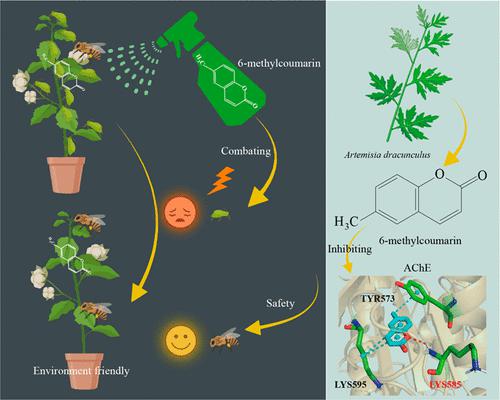当前位置:
X-MOL 学术
›
J. Agric. Food Chem.
›
论文详情
Our official English website, www.x-mol.net, welcomes your
feedback! (Note: you will need to create a separate account there.)
Development of Sustainable Insecticide Candidates for Protecting Pollinators: Insight into the Bioactivities, Selective Mechanism of Action and QSAR of Natural Coumarin Derivatives against Aphids
Journal of Agricultural and Food Chemistry ( IF 5.7 ) Pub Date : 2023-11-15 , DOI: 10.1021/acs.jafc.3c03493 Hong Zhou 1 , Yufan Jian 1 , Qingyi Shao 1 , Fuyou Guo 1 , Miao Zhang 1 , Fenglin Wan 1 , Liang Yang 1 , Ying Liu 1 , Li Yang 1 , Yanhong Li 1 , Pinglong Yang 1 , Zongquan Li 1 , Shili Li 1 , Wei Ding 1
Journal of Agricultural and Food Chemistry ( IF 5.7 ) Pub Date : 2023-11-15 , DOI: 10.1021/acs.jafc.3c03493 Hong Zhou 1 , Yufan Jian 1 , Qingyi Shao 1 , Fuyou Guo 1 , Miao Zhang 1 , Fenglin Wan 1 , Liang Yang 1 , Ying Liu 1 , Li Yang 1 , Yanhong Li 1 , Pinglong Yang 1 , Zongquan Li 1 , Shili Li 1 , Wei Ding 1
Affiliation

|
Plants employ abundant toxic secondary metabolites to withstand insect attack, while pollinators can tolerate some natural defensive compounds. Coumarins, as promising green alternatives to chemical insecticides, possess wide application prospects in the crop protection field. Herein, the bioactivities of 30 natural coumarin derivatives against Aphis gossypii were assessed and revealed that 6-methylcoumarin exhibited potent aphicidal activity against aphids but displayed no toxicity to honeybees. Additionally, using biochemical, bioinformatic, and molecular assays, we confirmed that the action mode of 6-methylcoumarin against aphids was by inhibiting acetylcholinesterase (AChE). Meanwhile, functional assays revealed that the difference in action site, which located in Lys585 in aphid AChE (equivalent to Val548 in honeybee AChE), was the principal reason for 6-methylcoumarin being toxic to aphids but safe to pollinators. This action site was further validated by mutagenesis data, which uncovered how 6-methylcoumarin was unique selective to the aphid over honeybee or mammalian AChE. Furthermore, a 2D-QSAR model was established, revealing that the central structural feature was H3m, which offers guidance for the future design of more potent coumarin compounds. This work provides a sustainable strategy to take advantage of coumarin analogues for pest management while protecting nontarget pollinators.
中文翻译:

开发保护传粉昆虫的可持续候选杀虫剂:深入了解天然香豆素衍生物抗蚜虫的生物活性、选择性作用机制和 QSAR
植物利用丰富的有毒次生代谢物来抵御昆虫的攻击,而传粉媒介可以耐受一些天然的防御化合物。香豆素作为化学杀虫剂的绿色替代品,在作物保护领域具有广阔的应用前景。本文评估了30 种天然香豆素衍生物对棉蚜的生物活性,结果表明 6-甲基香豆素对蚜虫表现出有效的杀蚜活性,但对蜜蜂没有毒性。此外,通过生化、生物信息学和分子测定,我们证实6-甲基香豆素对蚜虫的作用方式是通过抑制乙酰胆碱酯酶(AChE)。同时,功能分析表明,作用位点的差异(位于蚜虫AChE的Lys585(相当于蜜蜂AChE的Val548))是6-甲基香豆素对蚜虫有毒但对传粉昆虫安全的主要原因。该作用位点通过诱变数据得到进一步验证,揭示了 6-甲基香豆素对蚜虫的选择性优于对蜜蜂或哺乳动物 AChE 的独特选择性。此外,建立了2D-QSAR模型,揭示了中心结构特征是H3m,这为未来设计更有效的香豆素化合物提供了指导。这项工作提供了一种可持续的策略,利用香豆素类似物进行害虫管理,同时保护非目标授粉媒介。
更新日期:2023-11-15
中文翻译:

开发保护传粉昆虫的可持续候选杀虫剂:深入了解天然香豆素衍生物抗蚜虫的生物活性、选择性作用机制和 QSAR
植物利用丰富的有毒次生代谢物来抵御昆虫的攻击,而传粉媒介可以耐受一些天然的防御化合物。香豆素作为化学杀虫剂的绿色替代品,在作物保护领域具有广阔的应用前景。本文评估了30 种天然香豆素衍生物对棉蚜的生物活性,结果表明 6-甲基香豆素对蚜虫表现出有效的杀蚜活性,但对蜜蜂没有毒性。此外,通过生化、生物信息学和分子测定,我们证实6-甲基香豆素对蚜虫的作用方式是通过抑制乙酰胆碱酯酶(AChE)。同时,功能分析表明,作用位点的差异(位于蚜虫AChE的Lys585(相当于蜜蜂AChE的Val548))是6-甲基香豆素对蚜虫有毒但对传粉昆虫安全的主要原因。该作用位点通过诱变数据得到进一步验证,揭示了 6-甲基香豆素对蚜虫的选择性优于对蜜蜂或哺乳动物 AChE 的独特选择性。此外,建立了2D-QSAR模型,揭示了中心结构特征是H3m,这为未来设计更有效的香豆素化合物提供了指导。这项工作提供了一种可持续的策略,利用香豆素类似物进行害虫管理,同时保护非目标授粉媒介。































 京公网安备 11010802027423号
京公网安备 11010802027423号